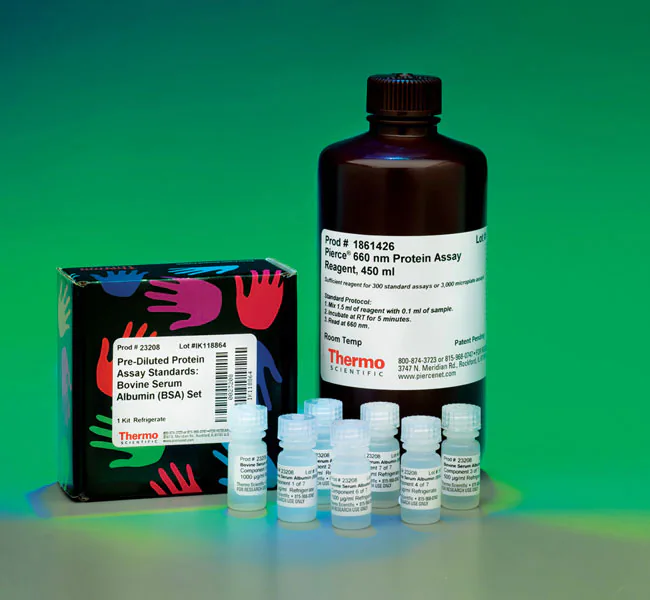
The Pierce 660-nm Protein Assay is a ready-to-use, detergent- and reducing agent-compatible assay reagent to quickly measure total protein concentration compared to a protein standard. The assay is more linear than Coomassie-based Bradford assays and compatible with higher concentrations of most detergents, reducing agents, and other commonly used reagents.
See all available protein assays ›
Features of the 660-nm Protein Assay Kit:
• Compatibility—works with a greater range of detergents and reducing agents than other dye-based assays
• Ready-to-use—single reagent with a simple mix-and-read protocol; no working reagent to prepare
• Linearity—produces standard curves that are more linear than with the Bradford assay method
• Assay format—assay may be performed in test tubes or microplates
• Sample volume—requires only 10 μL for microplate or 100 μL for the test tube procedures
• Storage—room temperature storage
The accessory Ionic Detergent Compatibility Reagent (IDCR) provides for even broader detergent compatibility, making this one of the only protein assays that is suitable for samples containing Laemmli SDS sample buffer with bromophenol blue. Although the Pierce 660-nm Protein Assay produces a higher level of protein-to-protein variation (37%) than other assays, such as the BCA Protein Assay, the simpler single-reagent format and broader substance compatibility make the Pierce 660-nm assay more convenient for many routine applications. The Pierce 660-nm Protein Assay can be performed in either a test tube or microplate format.
How the Pierce 660-nm Assay detects protein
The Pierce 660-nm Protein Assay is based on the binding of a proprietary dye-metal complex to protein in acidic conditions that causes a shift in the dye's absorption maximum, which is measured at 660 nm. The dye-metal complex is reddish-brown and changes to green upon protein binding. The color change is produced by deprotonation of the dye at low pH facilitated by interactions with positively charged amino acid groups in proteins. Therefore, the dye interacts mainly with basic residues in proteins, such as histidine, arginine, and lysine and to a lesser extent tyrosine, tryptophan, and phenylalanine.
The color produced in the assay is stable and increases in proportion to a broad range of increasing protein concentrations, even in the presence of detergents and reducing agents that would be incompatible with Bradford and BCA protein assays.
Related products
Pierce 660-nm Protein Assay Reagent
Ionic Detergent Compatibility Reagent for Pierce 660-nm Protein Assay Reagent
| Code | Description |
|---|---|
| 22662 | Catalog Number: 22662 |

